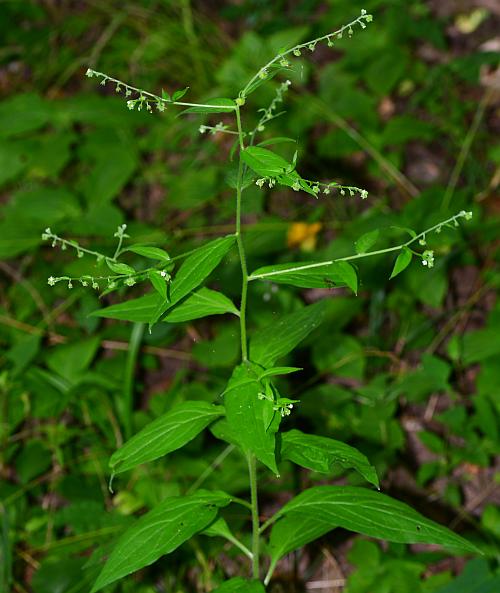Hackelia virginiana (L.) I.M. Johnst.
Beggar's Lice

Native
CC = 3
CW = 3
MOC = 50
© SRTurner
Hackelia virginiana (L.) I.M. Johnst.Beggar's Lice | |
 |
Native CC = 3 CW = 3 MOC = 50 |
© SRTurner |
|
Family - Boraginaceae Habit - Biennial forb with short taproot. Stems - Erect, to 1.2 m, usually solitary, few- to several-branched above the midpoint, tough and stout, moderately pubescent with short, fine hairs, these downward-angled toward the stem base, spreading to upward-curved above the stem midpoint.
Leaves - Alternate, simple. Basal leaves usually withered or absent at flowering, long-petiolate, similar to the lower stem leaves but shorter. Leaf blades 5-30 cm long, 20-100 mm wide, those of the lower leaves elliptic to ovate, becoming progressively narrower (to narrowly lanceolate) toward the stem tip, angled or tapered to a sessile base or those of the lower leaves with a short, winged petiole, tapered to a sharply pointed tip, the upper surface moderately roughened with minute, stiff, pustular-based hairs, the undersurface moderately pubescent with fine, minute, and somewhat longer, mostly minutely pustular-based hairs, especially along the veins, with 3-7 noticeable pairs of lateral veins.
Inflorescence - Terminal on the branches, usually paired, sometimes appearing axillary, appearing as dense clusters at the start of flowering, then becoming elongated into scorpioid, spikelike racemes, these usually appearing aggregated into leafy panicles, the flowers with stalks 1-4 mm long, these elongating slightly and spreading to drooping or recurved at fruiting, the lower and median flowers subtended by small, progressively reduced, lanceolate to linear bracts, the upper flowers bractless.
Flowers - Calyces actinomorphic, 5-lobed nearly to the base, the lobes 1.0-1.5 mm long at flowering, elongating to 2-3 mm long at fruiting, lanceolate, moderately to densely short-hairy, persistent and spreading to reflexed at fruiting. Corollas 1.7-2.5 mm long, more or less trumpet-shaped, actinomorphic, white, the tube 1.0-1.4 mm long, the throat with small, scalelike appendages, the 5 lobes 0.5-0.8 mm long. Stamens inserted at about the midpoint of the tube, the filaments very short, the anthers oblong or elliptic, not exserted from the corolla. Ovary deeply 4-lobed, the style very short, not exserted from the corolla, usually persistent but inconspicuous at fruiting, the stigma capitate, shallowly 2-lobed.
Fruits - Schizocarps, globose, 5-6mm in diameter, dividing into mostly 4 nutlets, these 2-3 mm long, erect, more or less angular-ovoid with a relatively sharp ventral keel, attached to the narrowly pyramidal gynobase at about the midpoint of the ventral keel, the attachment scar relatively broad, bluntly to sharply pointed at the tip, the surface with dense, tapered, apically barbed tubercles and minute warts or tubercles, brown.
Flowering - June - September. Habitat - Bottomland and mesic forests, streambanks, edges of pastures, roadsides. Origin - Native to the U.S. Other info. - This is a common species in Missouri, most commonly found in counties on the east and west sides of the state. Beyond Missouri its range extends throughout the upper U.S. Midwest, New England, and parts of Canada. The plant is usually recognized by its widely branched and spreading inflorescences and alternate, ovate leaves. The flowers of the plant are tiny and inconspicuous, but easily recognizable as belonging to the Boraginaceae due to their tubular 5-lobed design and the small crests (aka "fornices") at the base of the corolla lobes. The flowers are rapidly replaced by the distinctive fruits, which are densely bristly. Each bristle is barbed at the tip, so a close encounter with a mature plant will mean time spent later picking the fruits out of clothing, where they lodge tenaciously. For the same reason, pets with fur should be discouraged from visiting the plants. Photographs taken in the Ozark Scenic Riverways, Shannon County, MO., 7-20-04 (DETenaglia); also at Meramec Conservation Area, Franklin County, MO, 7-14-2020, along the Katy Trail near Treloar, Warren County, MO, 7-16-2020, and at Shaw Nature Reserve, Franklin County, MO, 8-28-2021 (SRTurner). |